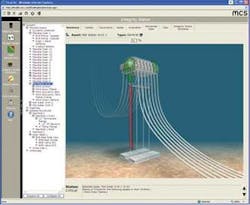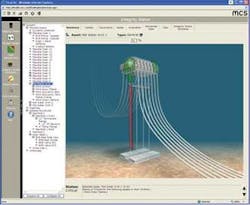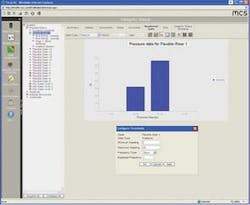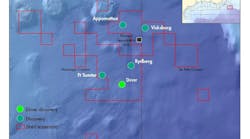Chris Saunders - MCS
Deepwater subsea systems operate in relatively inaccessible locations. This makes them difficult to inspect, repair, and maintain. As a result, operators increasingly see the benefits of integrity management systems to optimize inspection and repair strategies to increase system availability, and to reduce opex costs. To achieve this, some investment must be made up front.
The main problem associated with delivering a quality integrity management strategy is not technical understanding, but a commitment to implementation. An integrity management system cannot be considered as a collection of procedural and instructional documents. It is a “live” tool that enables integrity data to be analyzed, understood, and the status of the system determined.
Long-term plans
Integrity management of subsea systems has been adopted historically by the industry where there has been a local legislative or corporate requirement to do so. A recent example is in the US Gulf of Mexico, where draft regulations published in October 2007 require for the first time risk-based integrity management of riser systems.
More specifically, the regulations call for a documented Integrity Management program, an emergency response plan, and a personnel qualification program. These various measures would put US Gulf operations on par with the regime that came into force in the UK post-Piper Alpha.
Traditionally, the drivers for integrity management have been to ensure a safe system is in operation and to increase system availability in the short term. Today, however, operators look increasingly at their integrity management systems as a means to extend field life past the original design conditions. The quantity and quality of data required to make these assessments can be significant.
Integrity management of deepwater subsea systems is a special case, given the cost of subsea inspection and intervention, the limited inspection intervals available, the lead times for replacement or repair, and the emergence of new technologies for deeper and harsher environments. New inspection and measurement tools are being developed to mitigate some of these challenges, and more operators are considering implementing integrity management at the front-end engineering and design stages of new installations.
In recent years, operators have identified additional, non-regulatory benefits of an integrity management strategy, which include:
- Long-term field planning for life extension or re-use
- Reduced inspection costs through rationalization
- Next generation design benefits through capturing lessons learned
- An ability to plan proactively for repair and maintenance, rather than reacting to problems as they occur
- Increased system uptime and availability
- Spares rationalization.
Integrity management systems have three main building blocks:
- Risk assessment
- Inspection/monitoring strategy
- Periodic review.
Depending on the subsea component, guidance exists in the form of API / ISO specification, regulator guidance notes, or joint industry projects detailing how to technically conduct the assessments. One of the main problems associated with subsea integrity management systems is the vast quantity and range of data required. This can include:
- Historical process and production data such as pressure, temperature, flow rate, pH, composition
- Erosion and corrosion probe data
- Chemical injection data and material sample test results
- Dropped object register
- Vessel motion and metocean data
- Manufacturing history
- Design documentation
- Corporate and regulatory governance
- Risk assessment methods and results
- Corrosion management strategies
- Detailed inspection procedures and offshore work packs
- GVI and CVI videos and images
- Industry advances and best practices
- Future field requirements
- Specialist analysis and reports
- Pigging results.
All this data typically resides in separate and individual databases. In certain cases, cross-referencing data becomes difficult and is often considered in isolation. Data quality also can become an issue on aging installations where, over time, subsea sensors and topside probes have stopped functioning or limited data is available due to a lack of remaining system redundancy. Key staff change-out over the life of the asset adds another dimension. Other problems with data management include legacy systems, information exchange, and handover during ownership change.
Unless new technology for integrity management is considered during the early design stages of a subsea development, it can become technically or commercially prohibitive to retrofit. With different staff managing the opex and capex budgets, it can be difficult to make an argument for upfront investment, even where this is a relatively small value. This is true especially at the early stages of asset design when the opex budgets may not have been identified.
Commonly, integrity management systems focus on present-day status based on historical conditions. Very little time, however, is devoted to considering the system’s future suitability. Equally, subsea systems tend to be considered on a component-by-component basis which can mean that the bigger picture of the system integrity is missed.
Improving data quality
There are various methods and processes that an operator can adopt to improve the quality of inspection data gathered by ROVs. One way is to provide the ROV operator with a detailed set of inspection requirement documents prepared in advance of the survey. Alternatively, an integrity specialist can act as a client representative offshore during the inspection campaign so that decisions can be made on-site, limiting the need for follow-up surveys.
Software solutions are available that can analyze online process data quality, and use the data to undertake an integrity assessment for the system. The integrity status of the system is updated on a “continual/live” basis, preventing continued damage that may not have been detected until the next periodic review.
Integrity management reporting also can be improved by the use of online systems. A good integrity management system should be a live document, adapting to changes during the operation of the system.
It is common to end with yearly revisions of risk assessment reports, integrity management strategies, inspection schedules, anomaly reports, periodic review reports, and so on. These reports can take time to develop due to their size and, therefore, can be out of date before they are finished. Also, the size of these reports makes it difficult to identify key strategic issues hidden in the detail. Again, integrity management software solutions exist to help the engineer view the data at both a strategic and detail level.
Knowledge sharing is critical to any long-term project. When an asset is being acquired, the integrity status of the subsea system should be given due consideration to enable secure future operation of the system. This could be achieved through procedural management and identifying a responsible person.
Similarly, it is important to take lessons learned during the operation of an asset into the design phase of the next project. Often this may require additional cooperation with suppliers in the form of destructive testing of used subsea components at the end of service, or material analysis to identify whether prediction tools are accurate or if improvements can be made for subsequent design.
In terms of internal knowledge sharing, it is important that the information and knowledge remain in a system and not just within an individual. In this way, a more secure handover can be guaranteed.
Externally, various industry forums exist to promote knowledge sharing in which new technologies and issues can be discussed. Attendees can gain perspectives from other operators and companies in the industry. Local regulatory bodies also run similar events or they may be keen to provide their perspective on current issues.
Software advances
The use of alternative inspection technologies can offer savings in inspection costs along with additional value from the data itself. Examples such as topside i-tube-deployed cameras can negate the need for ROV work in the riser hang-off area and can provide information from an otherwise inaccessible place. Similarly, flexible risers can be vacuum tested to identify external sheath damage as an alternative to using ROV cameras.
Software systems play an important role in integrity management and their involvement is likely to expand as data requirements in the subsea industry increase.
The next generation of integrity management software involves intelligent analysis of the data, assessing changes in integrity status, and relaying visually to the end user both strategic and detailed information. These improvements should relieve management of some of the problems associated with data management and data sharing.
One such system is MCS’ software package ThruLife, which allows operators to extract and investigate the exact status of a subsea system at a glance, providing evidence of fitness for continued use that assists planning for repair or replacement. The software was developed following a survey of the subsea industry in 2006, which examined industry thinking, lessons learned, and new data on flexible pipe and steel catenary risers.
ThruLife interrogates all field data relating to integrity in a single repository, providing an at-a-glance status on the integrity of key components. It assesses the data and changes in integrity status, and reports these in visual form. Typically, the large volumes of data required for integrity management are in separate databases, but the MCS software brings it together to allow a full picture to be derived of the integrity of all components while subsea. It is designed to work with flexible and rigid risers, umbilicals, manifolds, pipelines, trees, control valves, and mooring systems.
Where MCS has deployed ThruLife in preference to traditional integrity management systems it typically achieves a 25% reduction in management costs on core integration activities. Currently the software is being implemented on numerous assets globally, including Marathon’sAlvheim FPSO development in the North Sea, where it supports the overall subsea integrity management process.





